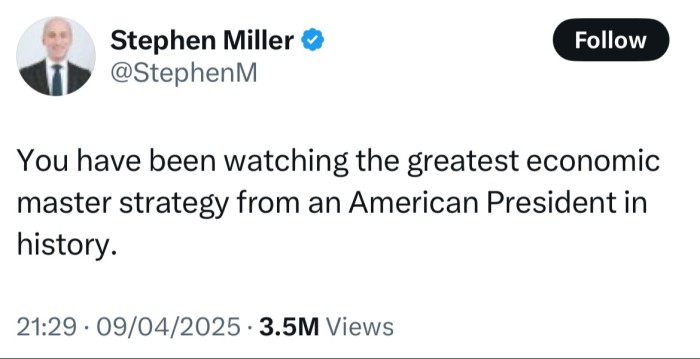Unlock the Editor’s Digest for free
Roula Khalaf, Editor of the FT, selects her favourite stories in this weekly newsletter.
Whatever Stephen Miller or Bill Ackman might say, it was the bond market that beat the Trump administration into an abrupt “PAUSE” for tariff negotiations.
The S&P 500 had nearly fallen into a bear market, but just two days of Treasuries puking was enough to force a rethink. The NYT has a good inside account of how much it swayed him. As Trump himself admitted:
I was watching the bond market. The bond market is very tricky, I was watching it. But if you look at it now it’s beautiful. The bond market right now is beautiful . . . I saw last night where people were getting a little queasy.
The bond market is hardly “beautiful” again. It’s notable that while stonks did stonksy things after president Trump backed down, the bond market has been much more circumspect. The 10-year Treasury yield actually rose again yesterday, and while it’s dipped a little today it is still at 4.32 per cent at pixel time, and well above the 3.86 per cent low touched less than a week ago.
But just how queasy did it get? Happily, JPMorgan’s rates analysts have published a report that looks across the Treasury market ecosystem, and the overall takeaway is that the Treasury market felt pretty sick, but not nearly as badly as it did in March 2020.
First of all, it definitely was an unusually turbulent week for Treasuries, and yields became completely unanchored from what the fundamentals would suggest.
Treasuries markedly underperformed other high-grade sovereign bond markets (oh, UK) and the depth of the market — as measured by the sum of the three best bids and offers across the Treasury curve — atrophied sharply.
However, as you can see from right-hand chart there, the Treasury market’s depth didn’t evaporate as dramatically as it did in March 2020, nor reach a similar low.
Yesterday the duration-weighted market depth across the Treasury curve reached a low of $67mn. That’s worst since the collapse of Silicon Valley Bank in early 2023 — and not great in a market that is supposed to be the most liquid in the world — but it is still better than the $38mn nadir of March 2020.
Moreover, JPMorgan’s analysts note that other measures of dislocations and distress were far less extreme. For example, while stale “off-the-run” Treasuries became less liquid and gapped out, it was nothing like what we saw in March 2020, and there didn’t seem to be any run to the liquidity of fresher “on-the-run” Treasuries.
What about the by-now infamous Treasury basis trade that Alphaville and others initially blamed for much of the turbulence?
JPMorgan says this is understandable — given the size and leverage involved — but it turns out that there aren’t that any signs of severe dislocations in various Treasury futures and their “cheapest-to-deliver” bonds, which is what you’d expect to see if there had been a disorderly unwind of basis trades:
While these are reasonable fears in deleveraging episodes, a close examination of Treasury futures bases show little signs of stress, and suggest that this is one corner of the broader market that is weathering the crisis very well so far.
Here’s a rundown of the gross and net basis across various Treasury futures, open interest in the contracts, implied repo rates and so on (zoomable version of the chart):
In other words, there probably were some Treasury basis trades being unwound, and simply given the size of the strategy this could have contributed quite a bit to the sell-off. Alphaville also gathers that things were starting to “crack” on Wednesday, so this could easily have become a bigger factor had Trump not bent the knee. But on the whole it was a fairly orderly basis trade retrenchment, and nothing like the chaotic unravelling that we saw in March 2020.
Similarly, JPMorgan says that wholesale funding markets — like commercial paper and repo — were volatile but remained orderly.
On the other hand, things were definitely not orderly in swaps. Or as JPMorgan puts it in understated sellsidese: “Moves in swap spreads have been nothing short of dramatic this week.”
On the face if it, this strongly implies that the swaps spread trade really was the biggest culprit in this latest bout of Treasury market turbulence.
Alphaville hasn’t been able to get even a rough estimate for how much money was betting on swap spreads normalising. The basis trade could still be the bigger contributor to the turmoil in Treasuries even though it was relatively less whiplashed, simply because of its size. But for now we can perhaps consider April 2025 primarily a Swapsmageddon [ed: Aswapscalypse, surely?] rather than a Basisclysm.
Anyway, all these trades are really part of the same elephant: interest rates arbitrage that rely on wholesale funding for massive amounts of leverage. And in an ideal world the US Treasury market wouldn’t be this susceptible to breakage.
Further reading:
— The trades threatening the Treasury market (FTAV)
https://www.ft.com/content/af032e00-982c-4507-8ae7-5acbedbc1b30


